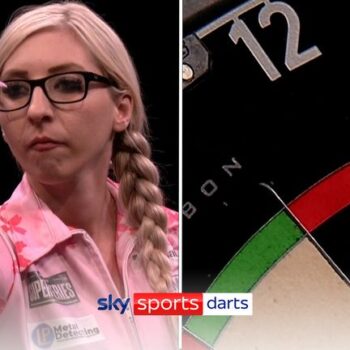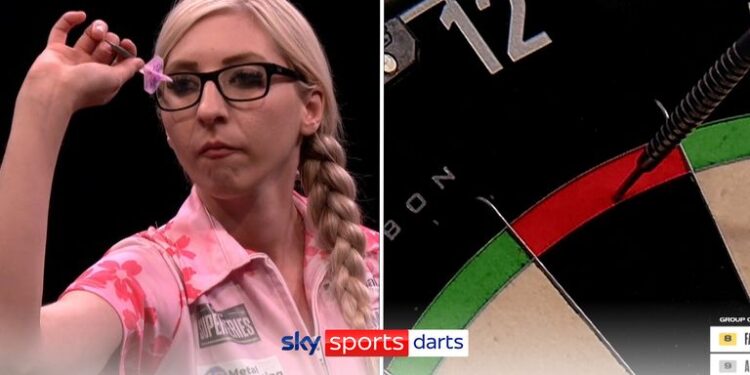**NINE-DARTER: First Woman to Hit Perfect Leg on TV – A Groundbreaking Moment in the History of Darts**

The sport of darts witnessed a historic milestone when the first woman achieved a nine-dart finish on live television, solidifying her name in the annals of the game and breaking new ground for female players worldwide.
Known as the pinnacle of perfection in darts, a nine-darter is when a player completes a leg in just nine throws—the minimum number of darts required to reach the score of 501, which is typically used in professional competitions.
Hitting a nine-darter is a rare feat, even among the elite male players, making this achievement all the more extraordinary and inspirational.
The remarkable moment unfolded during a televised event when the female player, calm and composed under the bright lights and intense atmosphere, strung together a sequence of pinpoint accurate throws.
She started with two perfect treble 20s, the highest scoring segment on the dartboard, followed by another treble 20 to complete the first set of three darts, totaling 180 points.
The audience, initially buzzing with excitement, grew increasingly hushed as they realized they were witnessing something special. For her second set of three darts, she replicated the same scoring—treble 20, treble 20, and yet another treble 20—amassing another 180 points and leaving her with a remaining 141 points to finish the leg.
At this point, all eyes were on the player as she took a deep breath and focused on her final set of three darts, needing to hit specific numbers to complete the nine-darter.
She chose to target treble 20, treble 19, and double 12, a traditional route often selected for a nine-dart finish.
Her first dart landed perfectly in the treble 20, leaving her with 81 points. She then shifted her aim to treble 19, effortlessly slotting the dart into the narrow segment, setting herself up for the crucial final throw at double 12.
The arena was tense, and the silence was palpable as she stepped back, took a moment to compose herself, and delivered the final dart with precision. The dart nestled right into double 12, completing the leg with a nine-dart finish.
The eruption of cheers, applause, and disbelief that followed signaled the magnitude of the achievement—not just for the player herself but for the sport as a whole.
Female players have long been striving to gain recognition and equal footing in a sport traditionally dominated by men, and this performance symbolized a significant breakthrough.
The nine-darter demonstrated not only her skill and composure but also the potential of female players to compete at the highest level and achieve the same, if not greater, standards of excellence as their male counterparts.
This moment of history-making brilliance did more than just secure her place in the record books; it also served as a powerful message for aspiring female darts players everywhere.
It showed that with dedication, practice, and self-belief, women can reach the pinnacle of the sport and execute even the most difficult of feats, such as a nine-dart finish.
Her accomplishment has become a source of inspiration and a rallying cry for more inclusivity and opportunities for women in darts, prompting discussions about expanding platforms and prize money for female competitors.
The televised nine-darter also had a ripple effect beyond the immediate darts community.
Mainstream media outlets and social media platforms exploded with coverage and commentary, celebrating her achievement and bringing newfound attention to the sport.
Her name trended on various platforms, with fans and fellow players alike expressing admiration and congratulatory messages.
This wave of recognition has contributed to a growing momentum behind women’s participation in darts, furthering the cause of gender equality and representation in sports.
The impact of this moment will likely be felt for years to come, as it not only set a new standard for female players but also changed perceptions about what women can accomplish in darts.
While there have been notable female competitors like Fallon Sherrock and Lisa Ashton who have broken barriers by competing in men’s events, this nine-darter serves as a reminder that women can deliver equally thrilling performances and meet the highest technical standards of the game.
In the wake of this landmark achievement, calls for increased television coverage of women’s darts have intensified, with fans demanding more live broadcasts and the inclusion of female players in high-profile events.
Tournament organizers and broadcasters have taken note, and there is hope that this nine-dart finish will lead to expanded opportunities, greater visibility, and a more level playing field for female players in future tournaments.
Ultimately, the first woman to hit a nine-darter on TV has etched her name in darts history and laid down a challenge for the next generation of female players.
Her legacy will not only be measured by this singular moment of perfection but also by the doors she has opened and the inspiration she has sparked for women across the sport.
This achievement stands as a testament to the power of perseverance, the importance of representation, and the belief that, in sports and in life, no dream is too big to achieve.










